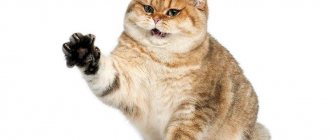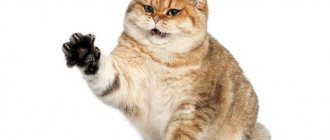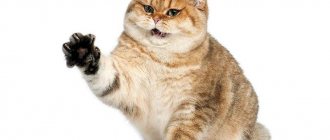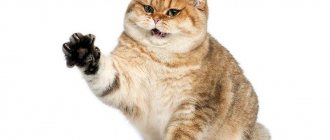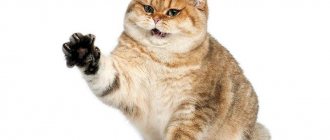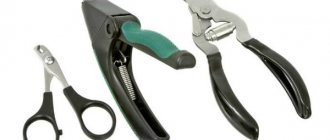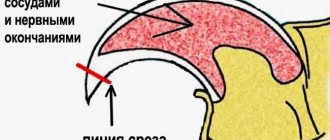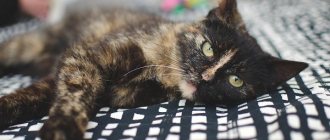For many domestic cats, nail trimming is a must. Growing nails cause discomfort to animals, and if they are not shortened in time, inflammation may begin. However, you need to properly prepare for a cat “manicure” and learn the technique of performing it. Then the procedure will take place with minimal stress and will not cause pain to the cat.
Which animals are not recommended for the procedure?
There is no need to trim the claws of a cat that roams freely outside. She needs her nails to climb trees, hunt and defend herself from other four-legged animals.
Also, the procedure is not performed on kittens under 1 month of age. Their claws are not yet formed. Early cutting negatively affects the structure of the nail plate and leads to delamination.
But already at 2 months the claws are strongly extended, and the kitten begins to scratch. At this time they can already be cut.
Tools for trimming claws
- For home use, small or medium nail clippers are often purchased.
- In veterinary clinics, professional tools are large nail clippers.
What tools does a veterinarian use to trim dog nails?
1. Nail clippers or trimmers are special scissors for trimming nails. They are sold in 2 types: in the form of nippers, like scissors, and rounded, sickle-shaped blades. You cannot cut it with simple scissors; they will split the claw.
2. A special file for treating your pet’s claws. The human will not take a strong stratum corneum.
3. Scissors with rounded tips. They are for cutting the fur located between the paw pads. This is the prevention of fungus formation.
4. Guillotine.
5. Machine or trimmer sharpener.
What tools can you use?
There are special nail clippers for trimming cat claws. It is not recommended to use nail scissors. They are designed for thin and flat nail plates of people. Such cutting tools lead to delamination.
There are several types of nail clippers:
- Blisters - resemble nail scissors, but have blades curved at the ends, designed for cat claws.
- Secateurs are equipped with a spring, which is located between the handles. As a rule, such models have a limiter. It allows you to cut only the desired length.
- Guillotines are similar to cigar scissors. The nail is placed in the hole at the end. When the handles are closed, the blade lowers and cuts the claw. The tool is suitable for cats with thick nail plates.
Each owner chooses the model that is convenient for him to use. The main thing is that it is made of high-quality materials and sharpened.
Additionally, you can buy an electric trimmer that allows you to quickly trim your nails. However, not all cats react calmly to it - the buzzing device scares the animals.
Important. When cutting, the blade of the guillotine nail clipper must move from bottom to top, otherwise the risk of crushing the nail increases. This is especially dangerous for kittens whose claw plates are not yet strong enough.
How to trim your dog's nails for the first time
If you are about to have your nails cut for the first time, you don’t need to get your hopes up that your dog will obediently give you his paw and obediently wait for the manicure to finish. Usually dogs are not too happy about such manipulations, especially without preparation. In order for everything to go with a bang, gather your courage, act decisively and carefully.
Over time, the dog will understand that there is nothing dangerous in trimming its claws, and will stop being panicky, nervous, and showing signs of aggression. Your task is to introduce your dog to manicure at an early age, so that in the future it becomes a habit and does not cause stress.
How often is nail trimming done?
The frequency of haircuts depends on the individual characteristics of the cat. For some, it is enough to carry out the procedure once a month, for others – every 2-3 weeks.
As a rule, light-colored nails grow faster. And in cats that prefer active games, partial wear occurs naturally. To determine the exact timing, you just need to carefully observe your pet.
For your information. A cat needs to have its claws trimmed before an exhibition, competition or other important event.
Why does the question arise about trimming a cat’s claws?
Cats need claws, primarily for defense, and they grow throughout their lives. A street animal usually wears them down on trees or other hard objects. A pet is deprived of this opportunity; as a result, the claws grow very quickly, begin to peel off, and grow into the paw pads. The animal suffers from discomfort and pain.
All cats have a dewclaw or false toe on their front paws, located just above the pads. It is not involved in any way in the basic functions (grasping, scratching, etc.) of the limb. The fifth claw also grows and the animal cannot grind it off on its own. If you don't take care of it, over time it will bend and grow into the pads, causing suffering for your pet.
Often cat owners have to observe the “activity” of their pets in the form of torn wallpaper, furniture, curtains and other things, so they advocate trimming their claws. They are supported by breeders of purebred cats, since this procedure is required by the exhibition regulations. A small kitten, several days old, already receives such a pedicure. Also, the procedure for shortening the sharp part of the claws is necessary if there are small children in the family. Parents must protect their child from accidental injury.
Leave a request for a cat hotel
Preparing for the first procedure
To trim a cat's claws with minimal stress, the animal is first accustomed to this procedure. It is better to start doing this in childhood. Kittens adapt to any changes more easily than adults.
For your information. There are cases where adult cats, accustomed to clinging with their claws while jumping, have fallen and been injured due to the fact that their nails were suddenly cut.
Preparations for grooming begin at a time when the cat is not doing anything (not playing, licking itself, eating or sleeping). They take her in their arms and stroke her affectionately.
Then they carefully move to the paws - they try to touch, lightly massage, imitate a haircut. At the same time, they talk to the pet and try to switch its attention to something interesting so that it does not break out.
As a rule, kittens do not like to have their paws touched, so the first 2-3 times they will get irritated and run away. But if you regularly repeat this exercise, the baby will get used to the manipulations. To reinforce the positive associations, he is given a treat at the end.
When the kitten begins to be calm about being touched, they begin to “rehearse” the haircut itself:
- put the pet in the desired position;
- take each paw in turn;
- examine the nails, press on the pads.
If the kitten tolerates all the actions, he is sincerely praised.
Then the pet is introduced to the nail clipper. It is important to show that the tool does not pose any danger. After the animal begins to treat him calmly, you can cut the kitten’s claws for real.
First aid for injuries
If a claw splits during trimming, most often a vessel will be hit and blood will flow. It needs to be stopped with one of the disinfectants.
Fits:
- hydrogen peroxide (3%);
- blood stopping pencil;
- iodine or potassium permanganate;
- corn starch or baby powder.
When the owner trims the claws, he places cotton pads, peroxide or a styptic pencil nearby on the bedside table or table. If the claw splits, pour a little peroxide onto a cotton pad and apply it to the bleeding wound.
Step-by-step instruction
A cat's claws consist of a keratinized layer, inside of which there is a pulp - a collection of nerve endings and blood vessels. When trimming, it is important not to touch a sensitive area, otherwise it will be very painful for your pet and blood will come from the wound.
In cats with light-colored claws, the pulp is clearly visible - it looks like a pink, crescent-shaped area. You can point your paw at a bright light or use a flashlight - the picture will be clearer.
It is more difficult to trim the claws of cats with dark pigmentation - you will have to act blindly. In this case, carefully cut off 1-2 mm at a time until the color inside becomes a little lighter - this is the beginning of the pulp.
For your information. Before cutting, remove the hair between the pads so that it does not interfere.
Nail trimming begins when the cat is calm, relaxed and ready to communicate. At this point, the owner should disinfect his hands and nail clippers, prepare cotton pads and antiseptic in case of injury.
Step-by-step instructions for trimming nails at home:
- The owner takes a comfortable position, puts the cat on his lap with his back to himself or lays him on his back. Particularly mobile pets can be wrapped in a terry towel.
- He takes the paw in his hand and presses on the pad to expose the claw.
- He brings the nail clipper to his paw. If the cat does not show concern, clicks it. In case of anxiety, he strokes and calms the pet, after which he repeats the manipulation.
- Now quickly and confidently sets the nail cutter 1-2 mm to the pulp and trims the claw so that the edge remains sharp. If you cut the platinum at the wrong angle, you will be more likely to hit the pulp.
- At the end, the cuts are rounded off with a nail file, giving a natural shape. In the future, you will be able to trim your claws less frequently if you regularly trim the overgrown areas.
If you trim your cat's nails correctly, your cat will not experience any discomfort. In fact, many animals struggle and hiss not because of pain, but because they are scared.
In order not to overwork the cat, the haircut is carried out in several passes. For example, one paw is treated daily.
Claw diseases in dogs
Improper or insufficient care of your dog's nails can lead to many unpleasant consequences:
- Ingrown claw. Untimely trimming or leaving the fifth toe untreated can cause the claw to bend and grow into the pad of the toe.
As the claw grows in, it disrupts the integrity of the skin; bacteria can enter the wound or fungus can develop. The dog experiences pain and does not stand on its paw: the stronger the discomfort, the less the paw is involved in walking.
- Inflammation of the claw bed, or panaritium. This condition can result from injury to a finger, claw, or adjacent tissue. The inflamed area becomes hot, swelling appears, inside which pus accumulates. Due to inflammation, the body temperature may rise, and the dog may experience loss of appetite. A dog's paw may smell unpleasant when the abscess opens and pus drains out.
- Breaking off a claw. It is also an extremely painful condition. When the claw is too long and catches on surfaces, with a sudden movement, the tip of the nail can break or come off completely - often breaking the blood vessel inside the claw. Almost always, breaking off a nail leads to severe bleeding - the dog cannot stand on its paw due to severe pain.
In some cases, the dog owner can treat the dog's painful condition on his own. For example, with felon - in the early stages of the development of the disease, it is necessary to carry out antiseptic treatment with various solutions (for example, chlorhexidine) with the application of wound-healing dressings. Bandages need to be changed periodically and make sure that the pet does not remove the bandage himself. You can use a special veterinary cap until the wound heals.
If a claw breaks off, you must first stop the bleeding, and then treat it and apply a bandage. If the claw does not break off very close to the pad, you can do without veterinary help.
However, with more serious consequences, when the dog does not stand on its paw at all, does not allow it to be examined or treated, with an ingrown claw, or if the paw is severely inflamed and the animal has a rise in body temperature and a general depressed state, you cannot do without an ambulance from a veterinarian. In such cases, surgery will most likely be required - under general anesthesia and under sterile conditions.
What to do if the animal is not given
To trim the claws of cats that categorically refuse this procedure, they use fixing overalls. They provide access to all limbs, but do not allow the pet to move freely.
At first, it is advisable to carry out the haircut with an assistant who will hold the animal. If the cat meows loudly and struggles, take a break. Let her rest and calm down for a while, then you can try again.
Important. You should not swear or shout at a cat if it resists while trimming its claws. Aggression from the owner will only frighten her. In the future, the pet will try by all means to avoid the unpleasant procedure.
Anatomy of a dog's claws
There is pulp inside the claw. She's soft. It contains a blood vessel + many nerve endings. On top is the stratum corneum. He's solid.
Together with the claw, the blood vessel grows and lengthens. When the owner does not trim it in time, it will subsequently have to be cut off along with the blood vessel. Part of the pulp is injured. While walking, the dog can infect the wound and become infected with tetanus.
Tools and items
To care for your pet's paws, you will need several tools.
Basic set
Claw cutter
The most important of them is nail cutters (tongs). It comes in different sizes and there is an opportunity to choose “your own” tool for any dog. The price range is quite wide: the minimum cost for a nail clipper starts from 100 rubles and can reach almost 500-600 rubles. On average, the instrument is sold for 200-300 rubles.
Another type of claw cutter is the guillotine.
Another model of nail cutter is the guillotine forceps. The guillotine model has only one blade, which appears in the hole when the handle is pressed. More suitable for small and toy breeds with thin nails.
Claw clipper guillotine
The guillotine nail cutter has a significant drawback: it is too noisy and can frighten less stress-resistant dogs. And if the dog gets nervous, then it will be extremely difficult to insert the claw into the special hole. This model sells for 400-600 rubles.
A similar nail cutter, the guillotine, is also used to trim cat claws.
File
Special file for sharpening claws There are special files for pets. Trimming may leave sharp scars on the nails. To prevent scars from causing torn furniture, and to prevent your pet from experiencing severe discomfort and even pain, the claws are carefully filed after the procedure.
It is not advisable to replace a file with a “human” one - people’s nails are much thinner than those of dogs and such a thin tool simply will not give the expected effect. The average price of a file is 100-500 rubles, depending on the manufacturer.
Trimmer
Battery-powered trimmer (grinder) Master groomers actively use trimmers (grinders). This is an analogue of a regular file, powered by batteries. The trimmer is a “wheel” with sandpaper that spins and thereby quickly grinds down the claw. The tool does its job much faster than a file. Some owners completely replace nail trimming with trimming using a trimmer.
What will be required additionally
Stocking up with just a nail clipper and file is not enough. You must have cotton pads, an antiseptic or a hemostatic agent with you. Chlorhexidine or talc, a hemostatic powder, will help treat the wound quickly and effectively. There is always a chance of damaging the pulp, and if this happens, you need to stop the bleeding immediately.
Will other scissors work?
It is a mistake to think that simple or manicure scissors will be an excellent replacement for a nail clipper.
- Manicure models are too small even for toy breeds.
- Standard scissors simply won't cut a dog's nail.
Even if you make every effort, you will not get the desired result. And, rather, on the contrary, this can only damage your pet’s finger.
What is a mat cutter for dogs?
How to train an adult cat to use a scratching post?
The situation is a little more complicated if the owner is faced with the problem of how to accustom an adult cat to a scratching post.
After all, you will have to somehow explain to the animal that you can no longer scratch the furniture or carpet, and draw its attention to a new unfamiliar object. To do this you need to arm yourself with perseverance and cunning. What should you pay attention to when choosing a scratching post?
What should you pay attention to when choosing a scratching post?
The first step is to choose the right drape so that your pet likes it. Several important details will help the owner choose the appropriate option:
- a cat’s favorite way to sharpen its claws (this can be one corner, a horizontal or vertical surface). Accordingly, the pet store selects a scratching post in the form of a column, rug or corner.
- stability of the drape - the ideal option would be a model with a heavy and wide base. After all, if she fidgets or suddenly falls under the weight of the cat, the animal will get scared, and this is unlikely to help in the question of how to accustom an adult cat to a scratching post.
Designs for sharpening cat claws are very diverse; a play complex with various platforms, shelves, tunnels and hanging toys would be an excellent choice. A scratching post with several tiers will be a favorite place for a cat, because here she will sleep, climbing higher, play and sharpen her claws. True, such a drape is not very cheap, but it will help keep your home interior intact and save money on buying new furniture.
Where to place the scratching post?
Initially, the most correct location for the claw grinder will be exactly the place that the cat has already liked to sharpen its claws. At first, the sofa or corner of the wall must be covered with something, or, if possible, the animal’s access to these places must be completely limited.
Draw your pet's attention in every possible way to such a new piece of furniture as a scratching post. How to train a cat to scratch it? First, call your pet to the drape or lure it with a game. Place the paws on the surface and gently press them so that the cat extends its claws into the upholstery material
Talk to her kindly, praise her, give her her favorite treat. The animal is unlikely to understand what’s what the first time, be patient and repeat this procedure several times a day. Every time your pet tries to scratch in the wrong place, pick him up and take him to the scratching post. Move the cat's paws along the drape again, tease with the toy to provoke it to release its claws into the upholstery. And reward the animal every time for the correct reaction.
Place the paws on the surface and gently press them so that the cat extends its claws into the upholstery material. Talk to her kindly, praise her, give her her favorite treat. The animal is unlikely to understand what’s what the first time, be patient and repeat this procedure several times a day. Every time your pet tries to scratch in the wrong place, pick him up and take him to the scratching post. Move the cat's paws along the drape again, tease with the toy to provoke it to release its claws into the upholstery. And reward the animal every time for the correct reaction.
Over time, when the problem of how to train a cat to sharpen its claws on a scratching post has been solved, and the correct habit has been developed, gradually move the drape to the place that you have previously thought up for it.
If the house where the cat lives is quite large, then it is better to get several scratching posts and place them in different places. One of them should definitely be placed near the place where the pet sleeps or spends the most time.
Best articles: Age of a cat by human standards
How else to attract a cat's attention to the drapery?
If you still cannot cope with the dilemma of how to accustom your cat to a scratching post, try treating the catnip with catnip (catnip). Cats really like the smell of this plant - it is sold in pet stores, both in dry form and in sprays, and is used to attract animals. And the sharp smell of citrus fruits will help scare your pet away from the sofa or wallpaper. A few drops of lemon juice applied to favorite places to sharpen claws will keep your pet away from there for a long time.
The main thing in this matter is persistence and consistency, do not expect success the first time. Remember, you can achieve the desired result with a little patience and affection.
How can you trim your pet's nails?
Pros often emphasize that ordinary scissors or clippers from a manicure set are not suitable.
They are a little disingenuous; if used carefully, these devices will not cause any harm. And not everyone has special nail clippers and trimmers. The most commonly used devices are:
- A nail cutter is a special scissors for trimming a cat’s claws, made of hard stainless steel.
The guillotine trimmer is suitable for beginners. After pressing the handle, the blade extends, quickly removing the desired section. A sickle-shaped device with a sharp arc is also good.
Nail clippers are also convenient for this type of work. But they need to be held perpendicular to the claw. If you “tilt” them at a large angle, the nail plate may delaminate, and such injuries are useless.
Use a nail file or a small block to correct the shape. These devices must be tough - animals have much stronger claws than ours.
As you can see, the devices are simple. Before the procedure, the instrument must be disinfected by wiping it with a solution or alcohol. It wouldn't hurt to stock up on hydrogen peroxide and cotton pads either.
Did you know? Among the staff of the British Prime Minister's residence on Downing Street, there was also a place for cats. The first title of the country's chief mouser was given to a purr named Veksel in 1924. Now Larry holds this post (this is his second “cadence”).
How often should the procedure be performed?
- Sedentary lifestyle or illness. If the animal is not very active, then it cannot sharpen its claws on its own.
- Room contents. Pets are unable to properly care for their nails. If a pet has the opportunity to walk outside, then it is able to cope with its problem on its own.
- If you have small children. A child and a cat do not always get along with each other. Often the animal can release its claws. Therefore, it is worth regularly giving your cat a manicure.
- Wash your hands well and sterilize the instrument.
- Hold your pet firmly and press on the paw pads until the claw appears.
- The device must be directed at right angles to the desired nail (direction from top to bottom).
- If the animal has a light-colored claw, then it needs to be trimmed within 1-2 mm of the pink area. For cats that have pigmentation, trim 1-2 mm from the tip of the nail so as not to damage the capillaries. If the pet has dark claws, they are trimmed in stages to avoid bleeding.
- Trim the claw in one motion.
- Sand the cut area with a nail file and treat with an antiseptic.
You should not keep your cat in an awkward position for a long time, as this can make her nervous. It is important to know that if a capillary was touched during the procedure, then a bandage or cotton wool moistened with hydrogen peroxide must be applied to it. In addition to this remedy, you can use Chlorhexidine. If you cannot stop the bleeding, you should contact your veterinarian. But usually such manipulation, if you have the proper experience, is quick and painless.
Owners of the Persian or Siberian cat breed will need a special hair clipper. These animals have a lot of hair near their paw pads. They prevent safe nail trimming. If your pet is frightened by the noise of the device, you can cut the hair using scissors. After the procedure, you can treat your pet with his favorite treat. Also, the animal must be praised for its exemplary behavior during the procedure.
On average, a domestic cat needs trimming once a month. If a young animal lives in the house, then a haircut should be done once every 2 weeks. At this age, claws grow faster than those of older cats. You should not skip this procedure, as the pet will get used to it very quickly and the owner will have to accustom him to the unpleasant manipulation again. If an animal is to compete in a competition, its claws must also be trimmed. Otherwise, the cat may be excluded from the competition.
Here you should take into account the individual characteristics of each pet, for example, the rate of growth and lifestyle. Active cats grind off some of their claws on their own, but lazy sofa kings do not. Consequently, the latter need manicure procedures more often. Observe your cat and choose the optimal trimming frequency.
The cat's claws are trimmed
The frequency of performing this procedure is strictly individual. The owner of the animal must find out how quickly the cat’s claws grow and create an individual schedule for the procedure. Some cats go through it no more than once a month, others have to go through a haircut 2, and sometimes 3 times a month.
If a cat not only lives at home, but also often walks outside, then, most likely, his claws will have to be trimmed much less often. They will wear off naturally. But not so effective that you can completely abandon the haircut.
The claw has an outer hard shell, under which the pulp is hidden. It contains blood vessels and nerve endings. The pulp occupies most of the claw. It cannot be damaged. The keratinized part is cut off. This is just a few millimeters at the very tip of the nail.
To avoid mistakes, you must first examine your pet’s claws in the light. They are well translucent and thanks to this you can see the border of the pulp of the keratinized tissue. It is along this border that the claws need to be trimmed.
Naturally, before starting the procedure you need to prepare the appropriate tools.
- Special scissors called nail clippers. They are made of durable stainless steel and are specially designed for this purpose.
- Guillotine trimmer. It is better for beginners to use this device. It is very easy to use and completely safe for your pet.
- Hard nail file. You can use a regular nail file from a manicure set.
All instruments must be disinfected before use. No need to boil. It is enough to treat the tools with alcohol.
It would also be useful to prepare cotton pads, hydrogen peroxide and an antiseptic - chlorhexidine. These items will come in handy if the owner touches the pulp.
In addition to the four working claws, with which the cat catches and holds prey, and tramples on its owners (by the way, massage-stomping is another reason to trim your pet’s claws on time - otherwise a pleasant trampling threatens to turn into a painful ordeal), the animal also has a fifth claw, which must be cut off.
Due to anatomical features, namely its location too high on the paw, the fifth claw cannot be sharpened naturally by walking on the ground or asphalt. In addition, it is located on the inside of the animal’s paw, so it cannot be ground off by wood or scratching posts.
The fifth claw is an invisible front of work that must be done before or after trimming the main claws. The main thing is not to forget about its existence, since the grown fifth claw can cause pain to the animal when walking.
Claws should be trimmed as they grow, approximately once every two to three weeks. This procedure should not be skipped, otherwise cats will quickly wean themselves off it and the owner will have to re-accustom the cat to trimming its claws.
An exception may be in cases where the pet is sick or is under stress.
Owners whose cats participate in exhibitions or competitions before such an important event must trim their pet’s claws, otherwise it may be disqualified.
How often should I trim my hair? It all depends on the individual characteristics of the cat. Experts in the field of felinology strongly recommend accustoming a meowing creature to this procedure from the age of a kitten. Then in “adult” life the pet will treat her more calmly.
You can accustom a baby kitten to a haircut after 1 month of life. Let us warn the owners: “Is it possible to trim a cat’s claws at such a young age?” It is possible and necessary! After all, the sooner a pet gets used to using a nail clipper or scissors, the faster and more painless the grooming process will be in adulthood. But it is up to the owner to clearly determine at what age a cat can be declawed through circumcision. And if the cat is too weak by 4 weeks of life, it is better to abandon the procedure for a while.
There is no point in carrying out the procedure earlier than 1 month. Firstly, the claws of newborn kittens are still too tender, unable to cause pain to either the mother cat or a person. Secondly, kittens under 1 month are not yet so active and spend most of their time on a cozy bed, drinking mother's milk and dreaming. Thirdly, the baby can easily damage the blood vessels located in the thickness of the small claw.
If for some reason an adult cat appears in the house, you can accustom it to grooming too. True, with a mature individual it will be a little more difficult (the cat can break out, hide, bite or scratch the owner).
- Take care of hand and instrument hygiene;
- Calm down, talk to the cat quietly and calmly;
- Place the purr in your arms, taking the tool (claw clipper) in your working hand;
- With your free hand, grasp the cat's paw, pressing on the pads of the fingers so that the claws extend to their full length;
- Holding the nail clipper perpendicular to the claw, cut off its curved tip without affecting the blood vessels;
- If necessary, file the claw with a nail file;
- Trim the claws on all the cat's toes;
- If the pulp is injured, treat with hydrogen peroxide;
- Praise your patient friend by giving him a treat.
Why do you need to trim your nails?
Under natural conditions, claws are constantly ground down on hard soil, tree bark, during hunting and games. But living in comfort and safety, pets show less activity, and scratching posts are among the available means for shortening manicures. Some pets simply ignore scratching posts and unknowingly doom themselves to constant discomfort.
There is another category of cats that definitely need to trim their sharp claws - these are overly aggressive pets, especially towards children, who love to scratch their legs and arms. Although in this case it is better to use silicone anti-scratch pads, because the sharp and uneven edges of a recently trimmed claw can cause unpleasant scratches.
With or without claws?
Is it possible to do something with the cat to prevent it from scratching? Veterinarians know 8 or 9 ways to deprive her of this opportunity. But after the most “humane” of them, the animal will feel like a child playing with tightly bandaged hands or walking in a straitjacket.
Impacts of “moderate severity” will cause sensations in the animal approximately the same as filling a carious tooth without painkillers in a person, and they will have to be used regularly: cat’s claws are constantly growing. And “radical” methods generally smack of fanaticism and leave the animal disabled.
How much does nail trimming cost at a veterinary clinic?
Experts know firsthand how to trim a cat’s claws. A veterinarian or professional groomer will assess the condition and perform a haircut with special scissors and sterile instruments. If necessary, the cat will be given a sedative and will not receive any physical or mental harm.
The cost of the procedure differs in different clinics. In Moscow prices vary:
- regular haircut – from 300-500 rubles;
- pruning under sedation – from 2000 rubles;
- manicure and installation of soft nails – from 1400 rubles.
In the regions, prices may differ slightly from those in the capital. The procedure is more expensive in private grooming salons, with comprehensive preparation for exhibitions.
Trimming claws is a necessary procedure that will not cause discomfort to the pet if the kitten is accustomed to it from an early age and done correctly. It is easy to carry out at home, finding an individual approach to your pet.
